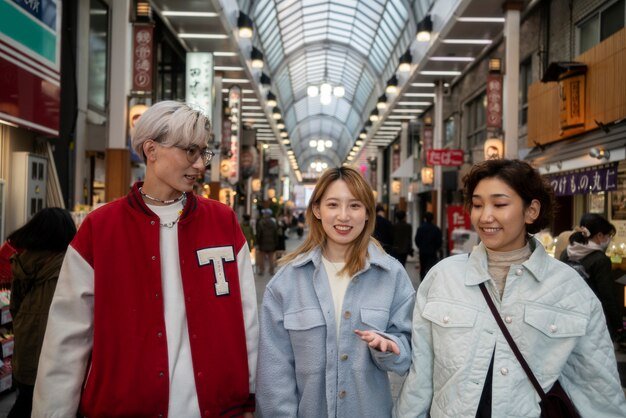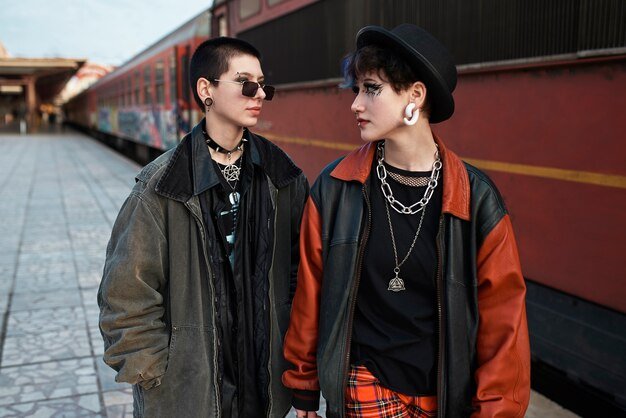Are Chains an Acceptable Fashion in Japan? Exploring Cultural Nuances and Style Trends
Introduction
Chains, once solely functional items for fastening or securing, have evolved into one of the most stylish and edgy accessories in the fashion world. These metallic elements, often associated with streetwear and punk aesthetics, have made their way into mainstream fashion across the globe, including in Japan. But Japan has its own unique fashion landscape with cultural nuances that can affect how accessories like chains are perceived. This blog explores the question, “Are chains acceptable fashion in Japan?” by diving into Japanese fashion trends, cultural perceptions, and how chains are styled and worn across different demographics and fashion genres in Japan.
Chains in Japanese Fashion History
In Japan, fashion has always been a blend of traditional aesthetics and modern influences. Historical Japanese attire, such as kimonos and yukatas, typically emphasizes subtlety, elegance, and refined patterns rather than bold, metallic accessories like chains. However, as Western fashion began to influence Japanese culture after World War II, accessories that might have once seemed out of place, like chains, began to gain traction in certain subcultures.
The Rise of Chains in Street Fashion
Chains became a prominent accessory in Japan through the influence of American and European street fashion. When streetwear took off in Japan in the 1990s, it was often associated with rebellious and countercultural movements, which used bold accessories like chains as symbols of individuality and freedom. For young people in cities like Tokyo, where subcultures such as punk, hip-hop, and goth thrived, chains were an essential part of the look. These styles were especially prominent in neighborhoods like Shibuya and Harajuku, where fashion is always evolving and pushing boundaries.
Chains and Japanese Subcultures
Japan is famous for its diverse and vibrant fashion subcultures, each with its own unique take on accessories and styling. Let’s look at some of the popular subcultures where chains play a significant role.
1. Punk and Gothic Styles
The punk and goth scenes in Japan have historically embraced chains as part of their visual identity. Inspired by Western punk culture, Japanese punk fashion incorporates chains, spikes, leather, and dark clothing. Chains in these styles are often seen on belts, jackets, and even as part of layered necklaces. In the gothic subculture, chains add an edgy, dramatic element to the typically dark and elaborate outfits, often decorated with crosses, skulls, and other symbols associated with goth aesthetics.
2. Visual Kei
Visual Kei is a unique subculture that originated in Japan, blending rock music with flamboyant, avant-garde fashion. Visual Kei artists, who often dress in elaborate costumes, frequently use chains in their accessories. Chains in Visual Kei fashion add to the theatrical, larger-than-life persona of these musicians, enhancing their look with an edgy, rebellious charm.
3. Lolita Fashion
Lolita fashion is known for its doll-like appearance, with dresses inspired by Victorian and Rococo styles. Although chains aren’t a core element in traditional Lolita fashion, some substyles of Lolita, such as Punk Lolita and Gothic Lolita, incorporate chains to create a fusion of elegance and edge. These chains are often used delicately, adding a touch of rebellion while still maintaining the feminine and elaborate nature of Lolita fashion.
Chains in Contemporary Japanese Fashion
Chains are no longer limited to subcultures in Japan. They have increasingly become part of mainstream fashion, particularly in urban centers like Tokyo and Osaka. Here’s a look at how chains are styled in modern Japanese fashion:
1. High-Fashion Incorporation
Luxury brands, both Japanese and international, have integrated chains into high-fashion pieces in Japan. Accessories like chain-link belts, chunky chain necklaces, and designer handbags with chain straps are popular among fashion-forward individuals. Brands such as Gucci, Chanel, and Japanese labels like Comme des Garçons and A Bathing Ape (BAPE) have used chains in their designs, bringing a sense of sophistication and luxury to the once-rebellious item.
2. Minimalist Street Style
In contrast to the more exaggerated use of chains in subcultures, Japanese minimalist fashion also embraces chains in a subtler way. Slim chain necklaces, delicate bracelets, and understated chain belts are common in minimalist street fashion, which is popular among young professionals and students. This look aligns with the Japanese aesthetic of “kirei,” or beauty in simplicity, where chains add a hint of personality without overpowering the outfit.
3. Gender-Neutral Fashion
Japanese fashion is known for its embrace of gender-neutral styles, and chains play a part in this trend as well. Gender-neutral fashion, popular among younger generations in Japan, often features simple yet bold accessories, including chains. Chains offer a versatile accessory that can be styled by anyone, regardless of gender, creating a sense of unity and inclusivity in the fashion scene.
Cultural Considerations: Acceptability and Perception of Chains
While chains are widely accepted in Japanese fashion today, cultural nuances play a significant role in how they are perceived and styled. In Japan, clothing and accessories often reflect one’s values, and certain styles may carry different connotations.
Chains as a Symbol of Rebellion
Chains have long been associated with counterculture and rebellion, both in Japan and abroad. Therefore, wearing heavy chains or styling them in a way that resembles punk or goth fashion may still convey a message of defiance or a desire to stand out from the norm. For older generations or those unfamiliar with the nuances of fashion subcultures, this look may appear unconventional. However, younger generations, especially those involved in fashion-forward areas like Harajuku, embrace chains as a symbol of freedom and individuality.
Chains in Professional and Social Settings

In professional settings, such as corporate offices, chains are typically toned down or avoided altogether, as Japanese business culture often favors conservative attire. A small, delicate chain necklace or bracelet might be acceptable, but heavy or multiple chains may be considered too casual or flashy for a formal setting. Socially, however, chains are commonly seen in casual attire, especially among younger people, and are generally well-accepted as a fashion accessory.
Respect for Tradition and Modesty
Japanese culture values modesty and respect for traditional values. While young people enjoy experimenting with fashion, there’s often a sense of respect for cultural norms and traditions. In this context, chains are styled in a way that balances personal expression with societal expectations. For example, instead of wearing chains in a loud or aggressive manner, many Japanese fashion enthusiasts incorporate them thoughtfully, blending tradition with modernity.
How to Wear Chains Fashionably in Japan
If you’re planning to visit Japan or are simply inspired by Japanese fashion, here are some tips on wearing chains fashionably and respectfully in Japanese settings:
1. Start with Minimalist Pieces – Opt for a simple chain necklace or bracelet if you’re unsure about how bold to go. Minimalist chains can complement a wide variety of outfits, from traditional to modern.
2. Layer Chains with Care – Layering chains can create a striking look, but it’s essential to avoid overdoing it if you’re in a more conservative or traditional setting.
3. Incorporate Chains in Casual Wear – Chains look best with casual outfits in Japan, especially in streetwear. Pair a chain necklace or belt with jeans and a T-shirt for an effortless, stylish look.
4. Respect Formal Settings – In professional or formal environments, it’s best to avoid large or flashy chains. Instead, choose delicate, refined pieces that add a hint of personality without drawing too much attention.
5. Match Chains with Japanese-Inspired Outfits – Experiment by pairing chains with Japanese-inspired outfits like kimono jackets, haori, or yukata-inspired tops for a unique blend of Western and Eastern fashion elements.
Conclusion
Chains have become an acceptable and stylish accessory in Japan, especially among younger generations and within various subcultures. While chains initially entered Japanese fashion through countercultural movements, they are now part of mainstream fashion, appearing in both high-fashion and street-style contexts. However, as with many aspects of Japanese fashion, the key to wearing chains lies in understanding the balance between self-expression and cultural respect.
Whether you’re exploring Tokyo’s bustling Harajuku district or attending a formal event, there’s a way to incorporate chains into your look that aligns with Japanese fashion sensibilities. From minimalist to bold styles, chains offer a versatile accessory that can be adapted to various outfits and occasions, making them an exciting addition to any fashion enthusiast’s wardrobe in Japan.














Post Comment